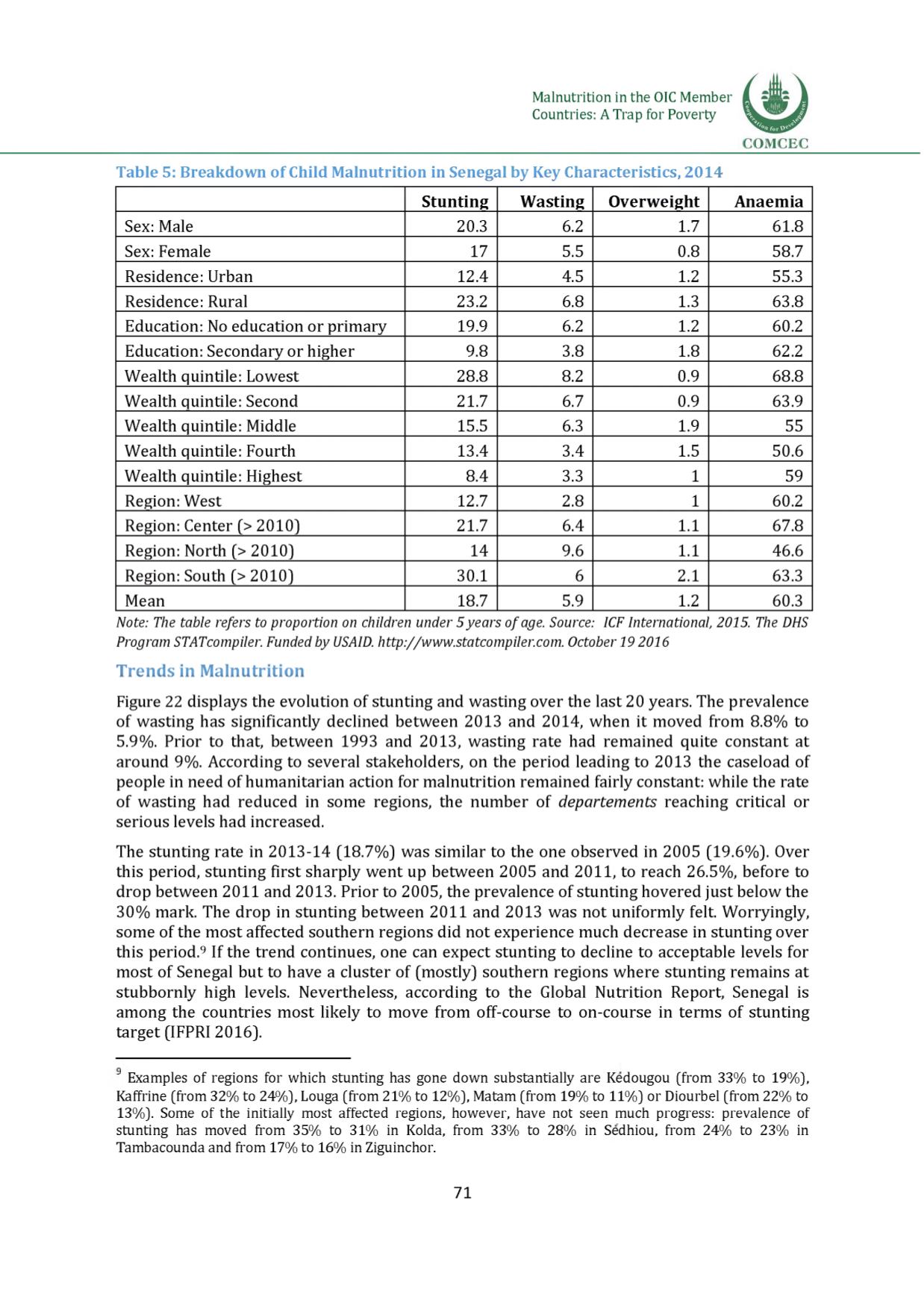

Malnutrition in the OIC Member
Countries: A Trap for Poverty
Table 5: Breakdown of ChildMalnutrition in Senegal by Key Characteristics, 2014
Stunting Wasting Overweight
Anaemia
Sex: Male
20.3
6.2
1.7
61.8
Sex: Female
17
5.5
0. 8
58.7
Residence: Urban
12.4
4.5
1.2
55.3
Residence: Rural
23.2
6. 8
1.3
63.8
Education: No education or primary
19.9
6.2
1.2
60.2
Education: Secondary or higher
9.8
3.8
1. 8
62.2
Wealth quintile: Lowest
28.8
8.2
0.9
6 8 . 8
Wealth quintile: Second
21.7
6.7
0.9
63.9
Wealth quintile: Middle
15.5
6.3
1.9
55
Wealth quintile: Fourth
13.4
3.4
1.5
50.6
Wealth quintile: Highest
8.4
3.3
1
59
Region: West
12.7
2. 8
1
60.2
Region: Center (> 2010)
21.7
6.4
1.1
67.8
Region: North (> 2010)
14
9.6
1.1
46.6
Region: South (> 2010)
30.1
6
2. 1
63.3
Mean
18.7
5.9
1.2
60.3
Note: The table refers to proportion on children under 5 years of age. Source: ICF International, 2015. The DHS
Program STATcompiler. Funded by USAID.
http://www.statcompiler.com. October 19 2016
Trends in Malnutrition
Figure 22 displays the evolution of stunting and wasting over the last 20 years. The prevalence
of wasting has significantly declined between 2013 and 2014, when it moved from
8
.
8
% to
5.9%. Prior to that, between 1993 and 2013, wasting rate had remained quite constant at
around 9%. According to several stakeholders, on the period leading to 2013 the caseload of
people in need of humanitarian action for malnutrition remained fairly constant: while the rate
of wasting had reduced in some regions, the number of
departements
reaching critical or
serious levels had increased.
The stunting rate in 2013-14 (18.7%) was similar to the one observed in 2005 (19.6%). Over
this period, stunting first sharply went up between 2005 and 2011, to reach 26.5%, before to
drop between 2011 and 2013. Prior to 2005, the prevalence of stunting hovered just below the
30% mark. The drop in stunting between 2011 and 2013 was not uniformly felt. Worryingly,
some of the most affected southern regions did not experience much decrease in stunting over
this period
.9
If the trend continues, one can expect stunting to decline to acceptable levels for
most of Senegal but to have a cluster of (mostly) southern regions where stunting remains at
stubbornly high levels. Nevertheless, according to the Global Nutrition Report, Senegal is
among the countries most likely to move from off-course to on-course in terms of stunting
target (IFPRI 2016).
Examples of regions for which stunting has gone down substantially are Kedougou (from 33% to 19%),
Kaffrine (from 32% to 24%), Louga (from 21% to 12%), Matam (from 19% to 11%) or Diourbel (from 22% to
13%). Some of the initially most affected regions, however, have not seen much progress: prevalence of
stunting has moved from 35% to 31% in Kolda, from 33% to 28% in Sedhiou, from 24% to 23% in
Tambacounda and from 17% to 16% in Ziguinchor.
71
















